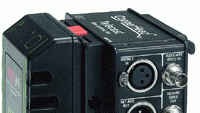

Telecast Fiber Systems’ camera-mounted CopperHead combines digital and wavelength multiplexing to send all ENG signals in both directions on a single fiber strand.
Over the last 10 years, two major technical advancements have spurred interest in fiber anew. HDTV occupies about 1.5Gb/s in transmission, and sending a signal with such high data rates is more practical when the transmission medium performs well at very high frequencies. SMPTE 292 works only to about 90 to 120 meters on coax, but it can be transmitted for kilometers on fiber. This applies to fiber-optic camera cable as well, though there is considerable industry concern about using fiber-optic camera cables in field production due to concerns over repair issues. Other high data rate signals, such as high bit rate compressed and uncompressed video (up to 360Mb/s), similarly suffer poor performance at long transmission lengths, i.e., more than 300 meters.
Fiber is a natural solution, and the development of more cost-effective hardware is spurring a surging interest in fiber equipment for delivery between buildings (or within a large facility) and as a connection to video interconnection companies. There has been a new class of equipment designed to transport SMPTE 259, SMPTE 292 and DVB-ASI (compressed MPEG-2). Like any new technology, it helps to understand the way it works and where the limitations are.
As with coax, fiber equipment is specified for a total loss budget for the “cable.” We generally do not think of the loss budget for coax, but look on the specifications sheet for your favorite cable. See the loss in dB/100 feet? That defines the loss of the medium, just like the similar figures for fiber. One difference is that the loss in fiber is not frequency-dependent, as most fiber used for video purposes carries a single frequency. To the loss in the cable, you must add the loss in the connectors, which cannot be as low as the loss in a BNC, but can be below 0.1dB. Add them up and subtract the loss from the absolute launch power, and then you get the power received at the far end of the medium. As long as there is margin left for the receiver to work properly, all should be well. Fiber links are never planned with the theoretical minimum loss, partially because the variance in the quality of installations can have an important effect on the total link budget.
Multimode fiber allows the beam to bounce back and forth across as it passes down the length of the fiber. There is some loss, though the fiber itself is larger in diameter and a bit more robust. Single-mode fiber has lower loss and is often lit from a laser source instead of a diode with wider dispersion and lower power. As a result, single-mode fiber provides much lower loss per Km and longer transmission distances. It is also more expensive and difficult to install.
Unlike coax, fiber can be illuminated from both ends, making a single strand capable of duplex transmission. To do this, the two ends use frequency diversity and optical hybrids to connect both the sending and receiving devices to a single strand. An ENG link using this approach would be very small and cost-efficient, though the loss in the hybrid somewhat reduces the distance that can be achieved.
The data transmission industry works with much higher bandwidths (data rates) than conventional video links. The implementation of high-bandwidth fiber services for telephony and data common carriers has proceeded at dizzying speed. One carrier provided a sample to me of an array of fibers arranged in a flat cable, stacked into a square bundle and encased in what looked like PVC. I thought it was perhaps 100 fibers, but it really was more than 850 in a “cable” less than 2.5 centimeters thick. That's one way to increase bandwidth.
The professional video industry's #1 source for news, trends and product and tech information. Sign up below.
Another is to use frequency division multiplexing on a single fiber. Send many light beams of slightly varying wavelength down one fiber and they won't interfere with each other. Modulate each one separately and that bundle of 800 fibers can carry thousands of signals.
Fiber finds lots of other uses in television. Get familiar with this technology because it won't be that long before your router and audio console have fiber connections on them. As consumer devices raise the manufacturing volume, we are likely to see more cost-effective and ubiquitous fiber-optic solutions in television.
John Luff is senior vice president of business development for AZCAR. To reach him, visitwww.azcar.com.
Send questions and comments to:john_luff@primediabusiness.com
